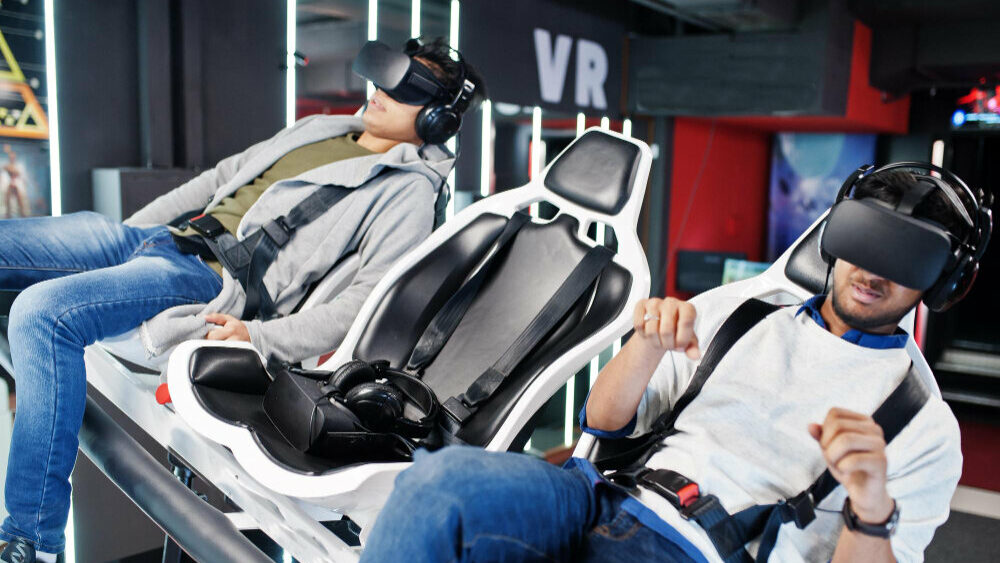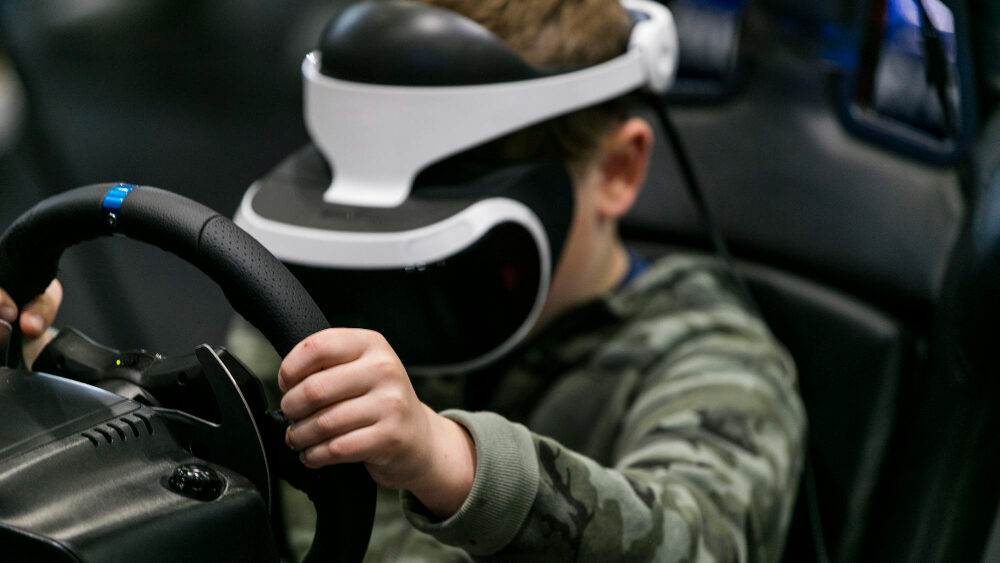Do you want to become a better driver without having to hit the road? Have you ever considered using driving simulators to improve your skills? With today’s technology, you can simulate different driving scenarios and test your abilities without any risk. In this step-by-step guide, we’ll take you on a journey through the world of driving simulators and show you how to rev up your skills.
But wait, what exactly is a driving simulator? Simply put, it’s a virtual reality tool that allows you to practice driving in a safe and controlled environment. You can simulate various scenarios, from everyday driving to emergency situations, and learn how to react to them in real-time. And the best part? Everything may be completed at the convenience of your own home.
“Why bother with driving simulations when I can just get out on the road?” you may be wondering. Well, the answer is simple. Using simulators can help you gain confidence, improve your reaction time, and teach you how to handle challenging situations that you may not encounter on the road every day. Also, it is a fun and exciting way of learning!
So, if you’re ready to take your driving skills to the next level, then buckle up and get ready to dive into the world of driving simulators. In this guide, we’ll cover everything you need to know, from choosing the right simulator to practicing different scenarios and much more. Get ready to rev up your skills and become a master of the road!
How Do Driving Simulators Work?
A driving simulator is a type of virtual reality software that mimics the experience of driving a vehicle in various environments and scenarios. It typically consists of a computer program that simulates driving situations, coupled with hardware components such as a steering wheel, pedals, and screens that provide visual and auditory feedback to the user.
When you use a driving simulator, you can experience a wide range of driving scenarios that might not be possible to recreate in real life, such as driving in hazardous weather conditions or practicing difficult maneuvers like parallel parking. You can also practice driving different types of vehicles, from passenger cars to large commercial trucks.
Benefits Of Using A Driving Simulator
1. Safer training
By using a driving simulator, you can provide your employees with a safer training environment than they would have in real-life driving situations. This can help reduce the risk of accidents and injuries during training.
2. Reduced costs
Instead of using company vehicles to train new drivers, you can use a driving simulator. This means your vehicles are available for business use while your employees learn in a virtual environment.
3. Customizable scenarios
With a driving simulator, you can create custom driving scenarios to meet specific training needs. For example, you can simulate hazardous driving conditions or specific types of terrain that your employees are likely to encounter in their jobs.
4. Improved training outcomes
By providing your employees with a more comprehensive and varied training experience, you can help them develop better driving skills and become more confident and competent drivers.
5. Better fuel efficiency
By using a driving simulator to teach your employees how to drive more efficiently, you can help reduce fuel costs and improve your company’s overall environmental footprint.
Overall, using a driving simulator for training can be a cost-effective and efficient way to provide your employees with a safe and effective learning environment. With customizable scenarios and a variety of training options, it can help your team develop the skills they need to drive safely and confidently on the road.

Different Types of Driving Simulators
1. Desktop Driving Simulator
A simulator designed to be tamed by your trusty desktop computer. Its affordability and accessibility make it the perfect companion for anyone seeking a simulation fix. Alas, the downside of this type of simulator is that it doesn’t provide a fully immersive experience. The user is left to interact solely with their computer screen, unable to truly escape into the simulated world.
2. Motion-Based Driving Simulator
Picture this: You’re cruising down the open road, wind in your hair, and a smile on your face. You hit a bump, and your whole body jolts with the sensation of driving. That’s the magic of a motion-based simulator, my friend! While it may cost a pretty penny compared to its desktop counterpart, the immersive experience it provides is second to none. So if you’re ready to take your driving game to the next level, buckle up and get ready for the ride of your life!
3. VR Driving Simulator
You’re behind the wheel of a car, cruising down the highway on a sunny day. But wait, you’re not really driving; you’re actually using a virtual reality driving simulator! This amazing technology immerses you in a realistic driving experience, making you feel like you’re actually on the road. The downside? You’ll need some pretty specialized gear to get the full experience, and it can come with a hefty price tag.
4. Full-Size Driving Simulator
Have you ever heard of a full-size car replica simulator? It’s like a giant video game, but instead of using a controller, you get to sit in the driver’s seat of a virtual car! This simulator offers the most realistic driving experience possible, without having to leave the safety of your own garage. However, just like the latest iPhone, this high-tech toy comes at a steep price, making it the least accessible option on the market.
How Do You Choose The Right Type of Simulator For Your Needs?
1. Identify Your Needs:
The first step in choosing the right simulator is to identify what you need it for. Do you need it for aviation training, driving practice, or medical simulations? Knowing your needs will help you narrow down your options and choose the simulator that is most suitable for you.
2. Research Your Options:
Once you have identified your needs, research your options. Look for simulators that have the features you need and are within your budget. Check out online reviews and talk to other professionals in your field to get their recommendations.
3. Consider The Level Of Realism:
Simulators come in varying degrees of realism, from basic to advanced. If you are a beginner, a basic simulator may be sufficient for your needs. However, if you are an advanced user, you may need a simulator that provides a more realistic experience.
4. Look For User-Friendly Interfaces:
Simulators can be complicated, so it is important to choose one with a user-friendly interface. Make sure the simulator is easy to use and has clear instructions.
5. Check For Compatibility:
Before making a purchase, ensure that the simulator is compatible with your computer or device. Some simulators may require specific hardware or software, so it is important to check the compatibility requirements.
Driving Simulator Set-up: Equipment, Software and Guide
Let’s go over the necessary equipment and software you will need for your driving simulator. You will need a computer or gaming system, a steering wheel and pedal set, and a monitor or virtual reality headset. As for software, there are a variety of driving simulation games available, such as Assetto Corsa and Project Cars.
Step-by-step Guide:
Step 1: Choose a location for your driving simulator. This could be a spare room in your home or a dedicated gaming space.
Step 2: Set up your computer or gaming system and monitor or virtual reality headset. Make sure they are all properly connected and functioning.
Step 3: Install your driving simulation game of choice and any necessary updates or add-ons.
Step 4: Connect your steering wheel and pedal set to your computer or gaming system.
Step 5: Configure your controls in the game settings to ensure they are properly calibrated.
Step 6: Start up the game and begin driving!
While setting up a driving simulator can be a lot of fun, there are also common challenges that may arise. For example, you may have calibration issues with your steering wheel and pedal set or difficulty configuring your controls in the game settings. Don’t worry; these challenges can be easily overcome with a little patience and troubleshooting.

The Future Of Driving Simulators
Let’s take a ride into the future of driving simulators. Picture yourself sitting in a sleek, high-tech cockpit with wrap-around screens and a steering wheel that feels like the real thing. As you start the engine, the simulator adjusts the vibration and sound to match the feeling of the road. You can choose any type of car or terrain, from a sleek sports car on a winding mountain road to a rugged off-road vehicle on a rocky terrain.
But that’s not all. In this future, driving simulators are not just for solo play. You can invite friends to join you in a virtual race, or even join a global racing league. You can also use the simulator to virtually explore new cities or even drive through historical landmarks.
As technology continues to advance, the possibilities for driving simulators are endless. One day, we may even see fully immersive simulators that let us experience the feeling of driving in a completely different body, such as a bird or a fish! The future of driving simulators is truly a thrilling ride, and we can’t wait to see where it takes us!
Summary
Driving simulators are an innovative and effective way to improve your driving skills. By using a simulator, you can gain experience and confidence in a safe and controlled environment, while also learning how to handle various driving scenarios.
Now, it’s time to take action and rev up your skills! Consider investing in a driving simulator for personal or professional use. You can choose from various types of simulators, each with its own advantages and disadvantages. Be sure to select the one that best matches your requirements.
Once you have your simulator set up, follow the best practices for using it and track your progress. Evaluate your training’s effectiveness by monitoring your skills and abilities over time. You might be shocked at how rapidly your skills develop!
Finally, keep an eye on emerging trends in driving simulation technology. As these technologies evolve, there may be even more opportunities to enhance your driving skills and stay safe on the road.
So, what are you waiting for? Get behind the wheel of a driving simulator and start revving up your skills today!
Frequently Asked Questions
What is a driving simulator?
A driving simulator is a tool used for simulating the experience of driving a vehicle in a safe and controlled environment. It can be used for training purposes, research, or entertainment.
What are the benefits of using a driving simulator?
The benefits of using a driving simulator include improved safety, reduced costs, increased efficiency, and the ability to practice driving in various scenarios without the risks associated with real-world driving.
What types of driving simulators are available?
There are various types of driving simulators available, including desktop simulators, cockpit simulators, and full-motion simulators. They can also vary in terms of the technology used, such as virtual reality or motion capture.
Can driving simulators be used for driver training?
Yes, driving simulators can be used for driver training, and are often used for this purpose in professional driving schools, as well as in military and emergency response training programs.
What features should I look for in a driving simulator?
When choosing a driving simulator, it’s important to consider factors such as the type of simulator, the technology used, the level of realism, the available features (such as motion simulation and weather effects), and the compatibility with your hardware and software.
How much do driving simulators cost?
The cost of a driving simulator can vary widely depending on the type of simulator, the technology used, and the level of customization. Some desktop simulators can cost a few hundred dollars, while full-motion simulators can cost tens of thousands of dollars.
Can driving simulators improve my real-world driving skills?
Yes, studies have shown that driving simulators can improve real-world driving skills by providing a safe and controlled environment for practicing driving techniques and scenarios.
Are driving simulators just for racing games?
No, driving simulators can be used for a wide range of driving scenarios, including driving in different weather conditions, on different types of terrain, and in emergency situations.
What are the best driving simulators on the market?
Some of the best driving simulators on the market include Project Cars 2, iRacing, Assetto Corsa, and Gran Turismo Sport, among others.
How do I set up a driving simulator at home?
Setting up a driving simulator at home can involve purchasing a simulator kit or building one from scratch, selecting the appropriate hardware and software, and configuring the system to work together seamlessly. It’s important to research and plan carefully to ensure that you have all the necessary components and that they are compatible with each other.





